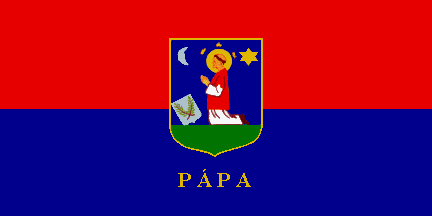 (1:2)
(1:2)image by István Molnár, 13 August 2001

Last modified: 2014-04-18 by zoltán horváth
Keywords: veszprem | papa | saint stephen |
Links: FOTW homepage |
search |
disclaimer and copyright |
write us |
mirrors
 (1:2)
(1:2)
image by István Molnár, 13 August 2001
See also:
Other sites:
Pápa is a small beautiful town in Veszprém County in Hungary
near to Gyor (45 km) and Veszprém (55 km) at the borders of the
Bakony Mountains and the Little Hungarian Plains. The town has
34,419 inhabitants (1990 census) nearly all of them are
Hungarians. Three of the Official Ethnic Minorities of Hungary
have ethnic councils in the town. They are: Gipsy, German and
Polish.
The territory has been populated from the Stone Age - a cemetery
of the Celts and Roman has been found. In the 6th-7th centuries
in the territory of the town there was a bigger Avarian
settlement. In Borsosgyor (village united the town in 1973) there
was an Avarian entrenchment (gyor ~ gyuru in English means ring).
After the Avars, the Slovenes had arrived they gave the name of
the brook of Pa'pa: Tapolca (in English means: hot water
brook).
The first mention of the town was in 1061. It was a borough in
1389 under the rule of the Garai family. In 1401 there was a
meeting of the Lords of Hungary convened by King Sigismund. The
Fort Pa'pa was built in 1444. In 1482 Pápa was a Royal Town with
3.000 inhabitants. In the time of the Turkish War (1525-1699)
Pápa was an important border fortress. It was besieged by the
Ottomans in 1543, 1551 and 1594. 1594-1597 and in 1683 was under
Turkish rule. In 1531 was found the Calvinist School,
1585-1952 it was a High School of the Calvinists. In
January 1704 the town led by the captain of the fort Pápa ,
La'szlo' Sa'ndor joined to Prince Ra'ko'czi. At the time of the
Prince Ra'ko'czi's Independent War the fort often changed hands.
In 1707, when the Habsburg Army occupied the fort, it burnt up
the town. In 1752 the fort was destroyed. Ka'roly Esterha'zy, the
landlord of Pápa built the castle in 1783-1784. At the time of
the Revolution and Independent War (1848-1849) citizens of Pa'pa
take up arms and went to the battles eagerly. After the defeat
the war leaders of Pápa were took prisoner. At the end of the
19th century Pa'pa was growing quickly. Because Pa'pa had got an
airfield (from 1937), it was bombarded in the WWII. Three
villages was united with Pápa : Borsosgy?r (1973),
Ke'ttornyu'lak (1977) and Tapolcafo~ (1982).
The coat of arms shows Saint Stephen, the martyr, whom name is
the title of the parish church. The first picture of the coat of
arms is from 1687.
You can see: former Esterha'zy Mansion (baroque 1783-1784) built
on the place of the destroyed fort, St Stephen Parish
"Old" Church (1774-1786), Museum of the Local History,
former Stable now Hotel Plata'n (classicist), High Square
(baroque), House "on Legs" or Arcade,
"Gate-House" (1750), Zichy House, Korvin Street,
Franciscan Church (1678-1764), Hotel Griff (1790),
Baroque-Classicist Reformed "Old" Church (1783-1784),
former City Hall (1823), Benedict Church (1737-1742) and former
Benedict High School, City Hall (1757-1898), former County Hall
(1823), "O'-kolle'gium" former Calvinist High School
(1797), Synagogue (Classicist 1846), former Cistercian Monastery
(1711), new Calvinist Church (1931-1934), Calvinist High School
(1894-1895, there learnt many famous Hungarian celebrities: Mo'r
Jo'kai - writer, Sa'ndor Peto~fi, poet...), Scientific Collection
of the Library of the Calvinist Church District, Museum of Blue
Dyers', Hospital (founded by Ferenc Esterha'zy in 1757, built
1763-1768), Old Mills (more of them ruin), City Park. The oldest
building of the town is in Ke'ttornyu'lak (name means: Settlement
with two tower) village. Small Romanesque Church with two tower
(first mentioned in 1360) - now Calvinist Church
István Molnár, 8 July 2000
Today is a National Holiday and I was on the ceremony in the
town. It seems Papa have got a common flag
only red and blue without coat of arms ratio 2:3 and a ceremonial
flag with coat of arms (90% of the height of the flag) with gold
fringes. Ratio 1:2. The colours of the coat of arms on the flag
are heraldic colours.
István Molnár, 15 March 2001
The image of the ceremonial flag is based on the flag given by
the Council of Pápa to the renewed railway station. Difference
between this flag and the more common one: gold fringes on the
three edge, and the type of the letters are different.
István Molnár, 13 August 2001
Resolutions about the symbols of Pápa (from 1974):
- Res. No. 3/1974. (X.18.) of Pápa town council about the Coat
of Arms of the town and Res. No. 4/1974. (XII.27.) of Pápa town
council about the flag of the town. Flag in use between 1 January
1975.- 31 December 1989 (see: 1975-1989 Flag)
- Res. No. 5/1989. (XII.21.) of Pápa town council modifying the
Res. No. 3/1974. (X.18.) of Pápa town council about the Coat of
Arms of the town. Flag in use between 1 January 1990- 28 February
1994 (see:Coat of Arms and 1990-1994
Flag)
- Res. No. 5/1994. (III.1.) of the Community of Town Pápa about
the symbols of Pápa Flag. Flag in use from 1 March 1994
- Res. No. 20/1995. (IV.27.) of the Community of Town Pápa about
Organisation of the Town. 2nd § about the symbols of the town:
The colours of the flag are colours of the Coat of Arms
RED: Pantone Red 032U; Pantone Red 032C.
BLUE: Pantone Process Blue U; Pantone Process Cyan.
Star: GOLD: Pantone 873 U.
Moon: SILVER: Pantone 877 U.
GREEN: Pantone Green U; Pantone 347 C.
- Res. No. 20/2004. (VII.7.) of the Community of Town Pápa about
the symbols of the town and the use of the symbols of the town.
Modified the use of the symbols (permission, illegal use,
punishment).
Source: Mayor's Office of Pápa Town.
István Molnár, 1 February 2007
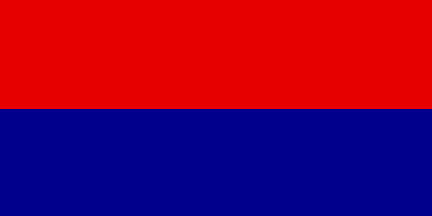 (1:2)
(1:2)
image by István Molnár, 15 August 2001
In Pápa on the streets you can see the red-blue flag without
the coat of arms only. Its ratio is 1:2, but you can see some
flags with ratio 2:3 too.
István Molnár, 15 August 2001
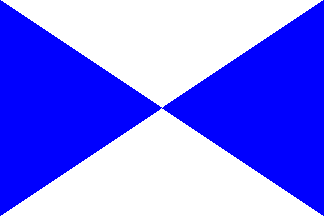
image by Antonio Martins, 28 Febuary 2001
This flag appears at Dr. Széll Sándor: Városaink neve,
címere és lobogója (1941) as "Pápa, Veszprém
Co.".
István Molnár, 20 October 2000
White and blue quarterly per saltire.
Antonio Martins, 28 Febuary 2001
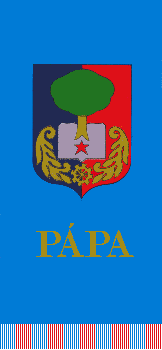
image by István Molnár, 4 December 2000
Description of the coat of arms: "The principal figure of
the Coat of Arms of the town is the "tree of the
knowledge" rooted in the "socialist culture",
which is encircled by the respected traditions and the symbols of
the modern industry."
From the book "A magyar városok címerei" Budapest,
1975
István Molnár, 4 December 2000
The Flag
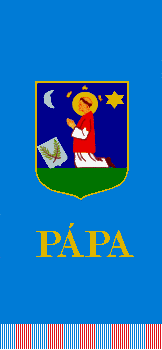 -
-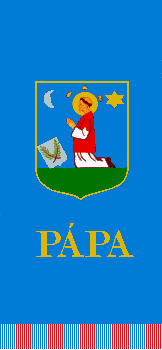
image by István Molnár, 1 February 2007
I havn't got enough information about the blue colour of the
shield.
István Molnár, 1 February 2007
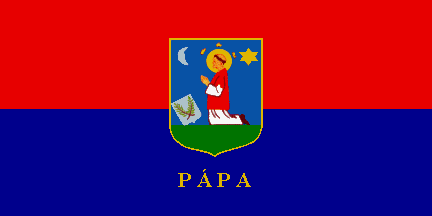
image by István Molnár, 1 February 2007
ve-pp.jpg)
image by István Molnár, 8 July 2000
Pápa used its coat of arms until 1948. In 1948 the new regime
forbade the use coat of arms. The town started to reuse this coat
of arms at the end of the 60's (you can see some prospectus).
From 1974 the towns could used coat of arms, but they have been
made new 'communist style' coat of arms which related to the
'socialist development', the 'power of the "labour
movement"' - red star. After the end of the communist era,
these coat of arms were removed.
István Molnár, 3 April 2001